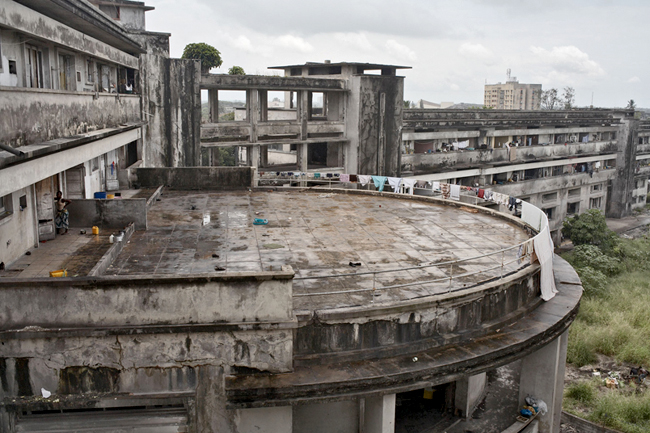He is never didactic, never bathetic and captures truths in the far corner of his lens that most photographers miss entirely. It’s no accident Tillim’s Avenue Patrice Lumumba, a series of vast prints taken in six African countries during 2007 and 2008, are displayed in Toronto’s Design Exchange. The retrofitted trading building, once home to the city’s stock exchange, was designed in the sixties by arch-modernist Mies van de Roehe. The view from the third floor, over a very Mies-ian pedestrian complex and two other identical buildings, brings the modernist project into stark relief. They are sparse, austere (if boilerplate) iterations of Van de Roehe’s decades-old search for Platonic ideals of form and function, and universally applicable truths through architecture.
In the context of Toronto, a largely functional developed world city, the modernist project retains a glint of its old utopianism, if also some of the menace of Ezra Pound’s demand to “make it new” - it, in this case, being all art. But in the Design Exchange exhibit hall, on walls that lead to this view of Mies-ian glory, we are confronted by a very different and far more complicated take on the modernist legacy.
In a series of large, rich photographs, taken in Ghana, Benin, Angola, Democratic Republic of the Congo, Mozambique and Madagascar, Tillim, now considered one of South Africa’s premier artistic voices, has sought out and photographed modernist structures built by colonialist and post-colonialist regimes around the time of those countries’ respective liberation struggles. The murmured stories double and triple up on one another, and we soon find the poison lacing Pound’s injunction to leave the past behind. (We’ll recall here that Pound’s flirtation with fascism was impossible to separate from his artistic obsession with the “new”.)
For one thing, the colonial regimes of Madagascar and Mozambique, the DRC and Ghana, Angola and Benin chose the modernist style as a reproof to the classicism that was a hallmark of early colonial building. They were, surely, submitting to the “fetishisation” of the modern fashionable at the time. But there can be little doubt that in turning to the modern, they were turning away from the past, and were in turn becoming specifically African. This didn’t make them better regimes. Rather it made them worse. In the darkest hour before they fell, the buildings they erected were statements of belonging.
That modernism continued into the post-colonial period is only one of the many head-scratching paradoxes buried in the Avenue Patrice Lumumba exhibit. The loose thread connecting all six countries, outside of modernist buildings, is the fact that Tillim’s photographs are all located on avenues named for the first president of an independent Congo. A didactic panel recalls Lumumba’s furious inaugural speech, which helped seal his fate, in front of the King of Belgium: Overt colonial control, he claimed, would not be replaced by malleable black regimes waiting to do their old masters’ bidding. A year later, Lumumba was dead, victim of machinations that extended far beyond the Congo delta. He leaves avenues named after him, and a bitter, complicated relationship with the West.
“These photographs are not collapsed histories of post-colonial African states or a meditation on aspects of late-modernist-era colonial structures, but a walk through an avenue of dreams,” writes Tillim. “Patrice Lumumba’s dream, his nationalism, is discernible in these structures, if one reads certain clues, as is the death of his dream, in these de facto monuments. How strange that modernism, which eschewed monument and past for nature and future, should carry such memory so well.” Brilliantly, Tillim has located the monumental in what were once intended as vital, forward-thinking buildings. He has linked them to the independence project. And he asks us to mull over that marriage.
Tillim’s photos are not, however, post-apocalyptic images of African rot. Only rarely, as in pictures of the Grand Hotel in Beira, Mozambique, does Tillim forget himself and concentrate on the structures, rather than their context. These buildings are used; they are the future. Nature has claimed some of them; trees curl through doorways and into ceilings. They are occupied. A typing pool works in a dilapidated office; a new umbrella lies on a filing cabinet; laundry hangs over balustrades. They are pieces of contemporary African cities, only discernible if you understand their histories.
Tillim’s term for these structures, these dreams, is “Floating worlds”. That is a beautiful evocation of what modernism in Africa has become?unmoored from its ideals, broken from the stream of history in which they were created, they nonetheless carry on as functional buildings, where people work, live and play. “In the frailty of this strange and beautiful landscape struggling to contain the calamities of the past 50 years, there is an indisputably African identity,” writes Tillim. “This is my embrace of it.” DM
Photo: Guy Tillim, Grande Hotel, Beira, Mozambique, 2008 (diptych a) © Guy Tillim.




